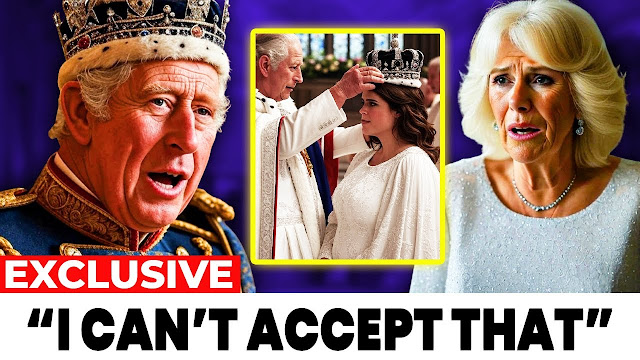Ads
In May 2024, the historic Garrison Chapel in Chelsea—once a sacred place for soldiers preparing for battle—was transformed into a beacon of new beginnings. The occasion marked the launch of a transformative new chapter for Princess Eugenie. At 35, she stepped into the chapel not as a spectator but as a central figure in King Charles’s ambitious “35 under 35” initiative. This program, celebrating 35 years of the King’s Foundation, spotlighted young changemakers in social care, environmental stewardship, the arts, and sustainable development. Princess Eugenie’s role as a mentor within this elite group not only symbolized trust from the monarch but reflected her personal evolution—from a quietly supportive royal into a woman of purpose and influence.
Clad in a striking emerald green dress tailored especially for the day, Eugenie exuded warmth and elegance as she engaged with each young recipient. Her approach wasn’t ceremonial—it was personal. Her own life, marked by both privilege and challenge, added depth to her connection with these young trailblazers. For Eugenie, the day was more than a celebration—it was the rewriting of her royal narrative. Gone were the shadows of past family controversies. In their place stood a woman championing progress and using her platform for meaningful change.
Ads
But within the elegant setting, whispers of tension lingered. Royal transitions are rarely without friction. King Charles, in reshaping the monarchy, seeks a delicate balance: maintaining cherished traditions while ushering in modern relevance. The King’s Foundation, formerly the Prince’s Foundation, embodies this mission. Founded in 1990, it has long reflected Charles’s deep-seated passions for nature, architecture, and community welfare. The foundation’s projects have restored schools, rejuvenated villages, and helped revive lost crafts. More than a philanthropic arm, it has become a cornerstone of the King’s vision for a sustainable and compassionate future.
When Princess Eugenie joined this mission as mentor to the foundation’s emerging young leaders, her appointment carried weight. It wasn’t just about family. It was a statement—that she represented the monarchy’s next chapter. Her own background, shaped by elite education, international work experience in art and auctions, and her steadfast independence, made her a natural fit for the evolving royal narrative. From her early schooling with her sister Beatrice to her time at Marlborough College, and later her bold leap into New York’s competitive art scene, Eugenie has steadily carved a path blending public duty with personal growth.
Ads
After returning to London in 2015 and assuming a leadership role at Hauser & Wirth, a globally renowned art gallery, she further deepened her ties to the cultural world. Her passion for visual arts merged seamlessly with her advocacy, especially on environmental and human rights issues. From promoting eco-conscious weddings to fighting modern slavery, Eugenie has demonstrated that royal service doesn’t always wear a crown—it sometimes shows up in boardrooms, on grassroots projects, and in heartfelt speeches about a better world for her sons, August and Ernest.
However, not all within the palace watched this ascent with enthusiasm. Behind the gilded curtains, Queen Camilla reportedly grew uneasy. It’s not that Camilla and Eugenie were openly at odds, but rather that their paths began to cross in subtle yet significant ways. Camilla, who had meticulously crafted her image over the years—from controversial outsider to respected Queen Consort—felt overshadowed by a younger royal’s rising influence. This tension deepened when Camilla’s daughter, Laura Lopes, a talented curator and co-founder of her own gallery, was suggested as a potential mentor for the same “35 under 35” program. Insiders revealed that her nomination was declined due to her lack of an official royal role and limited public visibility—factors that Eugenie, with her title and platform, naturally possessed.
Ads
It was a quiet rejection, but it struck a nerve. Camilla, proud of Laura’s achievements, had hoped to elevate her daughter’s public standing through the royal initiative. The foundation’s choice to go with Eugenie instead was interpreted by some as a signal—one that placed Eugenie squarely in the spotlight. This decision echoed past moments of subtle friction, such as Camilla’s absence from Eugenie’s wedding in 2018, officially explained as a scheduling conflict, though many speculated otherwise due to the ongoing controversies surrounding Prince Andrew, Eugenie’s father.
In the world of royalty, power dynamics often play out in silence. A missed wedding, an overlooked nomination, a title granted to one and not the other—these are the unspoken cues that shape relationships behind the palace doors. As Eugenie’s public approval grows, fueled by her relatable blend of royal tradition and working mother authenticity, it’s no surprise that some feel the shifting balance.
Ads
Yet Eugenie remains focused on her work. Her efforts to support new artists, lift marginalized voices, and inspire change through programs like “35 under 35” are not just acts of duty but expressions of genuine commitment. Her mentorship has helped spotlight young innovators like Zahara Adamu, a crop specialist focused on climate-resilient agriculture, and Lia Chen, a teenage inventor whose biodegradable glitter has already replaced plastic glitter at major festivals. This next generation, many of whom come from diverse or disadvantaged backgrounds, reflect the inclusive future King Charles envisions—and Eugenie is at the heart of it.
Through her dual role in the art world and the royal family, Eugenie bridges the past with the future. She proves that being a royal today means more than wearing a tiara. It means working hard, caring deeply, and lifting others as you climb. And while Camilla may feel unsettled by the new spotlight shining on her step-niece, the truth remains: Princess Eugenie’s star is rising not because she sought it—but because she earned it.


إرسال تعليق